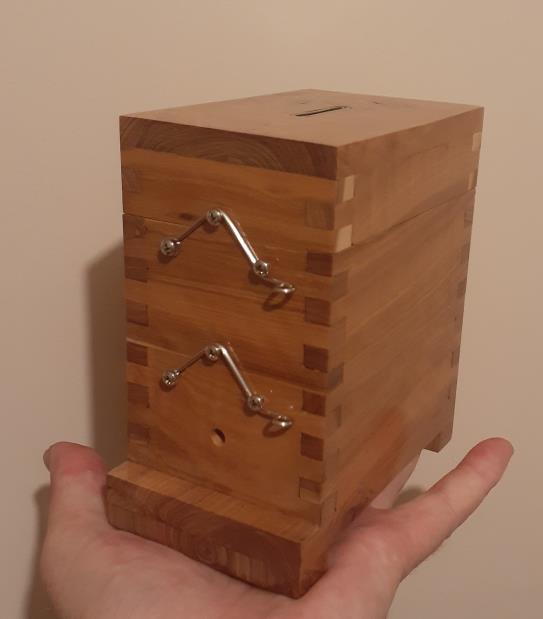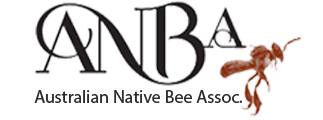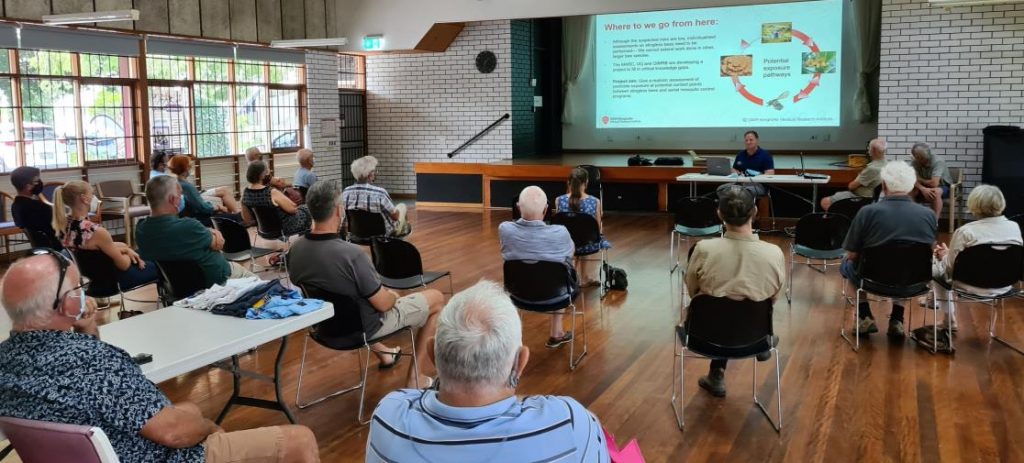Report of February meeting
In the absence of Dean, Tim chaired this meeting and began by welcoming those here in person and those attending by Zoom to our first meeting of 2022. We honour the traditional owners and custodians of Brisbane, the Turrbal and Jagera people, who speak the yaggera language.
The Main Business was a fantastic talk summarized here.
Pesticides, Mosquito Control & Native Bees
There’s been plenty of concerns over the years about council spraying mangrove areas with pesticides to con-trol mosquitos and if it has any adverse effects on our native stingless bees.
Dr Brian Johnson (QIMRB) and Dr James Hereward (UQ) presented their research at the Brisbane branch of the ANBA – 6 February 2022.
Brian is a senior research officer at QIMR-Berghofer Medical Research Institute and MARC – Mosquito and Arbovirus Research Committee – an independent Australian body involved in mosquito research, http://marc.net.au.
Brian is passionate about using environmentally safe and sustainable practices to control mosquitos. Council has moved completely away from broad scale application of insecticides to control adult mosquitoes towards softer applications of biological compounds to control the larval mosquitoes before they emerge.
Two pesticides are applied by council to control mosquitos. Both are applied at very low concentrations to the salt marsh water bodies where the larval mosquitoes are breeding. The insecticides are a bacterium (Bti) and an insect hormone (S-methoprene). Both are completely safe to humans, but could potentially affect non-target insects, such as native bees.
Bacillus thuringiensis var. israelensis (Bti) is a naturally occurring bacterium that is pathogenic to select aquatic insects like mosquitoes, blackflies and fungus gnats s. It is applied as a liquid that contains spores that produce toxins that specifically target the larvae. These insects have an alkaline digestive tract of pH>7 which is required to activate the toxins. Honey bees digestive tracts are acidic at pH<5. It is thought that the digestive tract pH of stingless bees is similar to honey bees. In addition to pH, Humans, animals are non-targeted insects are not affected because they lack the appropriate receptors for Bti toxins to attach to.
S-Methoprene, is applied as a liquid or pellets. It is a synthetic analog to the insect growth regulating hormone, juvenile hormone (JH). JH regulates larval moulting and prevents the harmless mosquito larvae from metamorphosising to the biting adult stage. S-Methoprene is used to control other insects. is commonly found in treatments for dog, cats and in cattle feed, and is approved by the WHO for use in drinking water cisterns.
S-Methoprene Is not active against adult insects. It acts by mimicking JH which must be absent for pupae to successfully moult into adults.
There have been quite a few studies of the impact of these pesticides on Honey bees. Bti has no impact. S-Methoprene can have an impact at higher concentrations, but the risk of exposure of honey bees has not been investigated. While it’s thought there’s no or minimal impact on stingless bees, there hasn’t been any specific research.
Research needs to focus on two aspects:
- The toxicity of increasing does on the animal (these studies are typically done in the lab).
- The risk of the insect being exposed to the insecticide in real world field situations.
It’s thought that stingless bee colonies will be outside of the direct treatment areas so there should be no risk at the time of application. The pesticides can be applied in granular or liquid forms. The liquid should have minimal drift at around 50 metres distance but may make contact with foraging bees, especially if plants are flowering at the time of application.
The ground water in the treated areas is saline so it’s not attractive to bees and there’s no evidence that the plants will uptake or absorb the pesticides through ground water and contaminate nectar or pollen.
Liquid pesticides may contaminate flowers if present at time of application. The bees can transport the pesticides back to the colony, if flowering occurs when treatments are being applied.
More research required…
APVMA (The Australian Pesticides and Veterinary Medicines Authority) regulates pesticides but only requires that honey bees be tested. Despite this, MARC, UQ and QIMRB are determined to understand if other non-target organisms may be affected. Hence they are developing a project to look at how or if stingless bees use these saltmarsh / mangrove areas and to detect any pesticides inside stingless bee colonies. They will also look at the effect of doses of the insecticides on the bees. Dr James Hereward spoke about some of the details and methods to be used in this research.
Contacts: brian.johnson@qimrberghofer.edu.au and j.hereward@uq.edu.au
Branch business
After thanking the speakers, we attended to some branch business.
Members were encouraged to help disperse the ANBA leaflets. Those who sell hives or other products are in a top position to distribute information to potential new members.
We discussed future meetings for 2022. We have a few spots to fill, so we asked for suggestions from members on what they would like to hear more of. Responses included: more photographic exhibitions and a bee identification talk.
World Science Festival 2022, 13 March
The Australian Native Bee Association will partner with Butterfly & Other Invertebrates Club on 13 March 2022 at Southbank to present an interesting and informative display to the public as part of the World Science Festival. We need volunteers to help at the display – if you require more information and would like to register your interest, please contact Ian Driver at pres@australiannativebee.org.au
Get your tickets for the Great Hive Raffle
Last month we featured the first prize in our GREAT HIVE RAFFLE: a stunningly decorated native bee hive stocked with a colony of carbonaria bees. But check out second prize: Doug Irvines generous contribution to the raffle hive: an exquisitely made miniature stingless bee hive, which functions not to house bees but as a novelty money box. This raffle serves to raise funds for the Brisbane Branch, so we can pay for hall hire, speaker gifts, etc. There are limited ticket numbers, get ‘em at the next meeting. Or tickets can be purchased from Dean Haley truebluebees@gmail.com with EFT to the Brisbane Branch bank account. You will receive a ticket number and a receipt.
Next meeting, 6th March
Our next meeting will be held on Sunday 6th March 1pm, at Bulimba Community Centre, 1 Barramul St, Bulimba. Free for members, $5 for non-members. ANBA members can attend by Zoom, a link to join will be sent by email prior to the event. Sarah Hamilton will be speaking. . Masks and vaccine certificates required please.
For more info on branch activities, visit our Facebook page Brisbane Branch, Australian Native Bee Association, https://www.facebook.com/bnbeec


